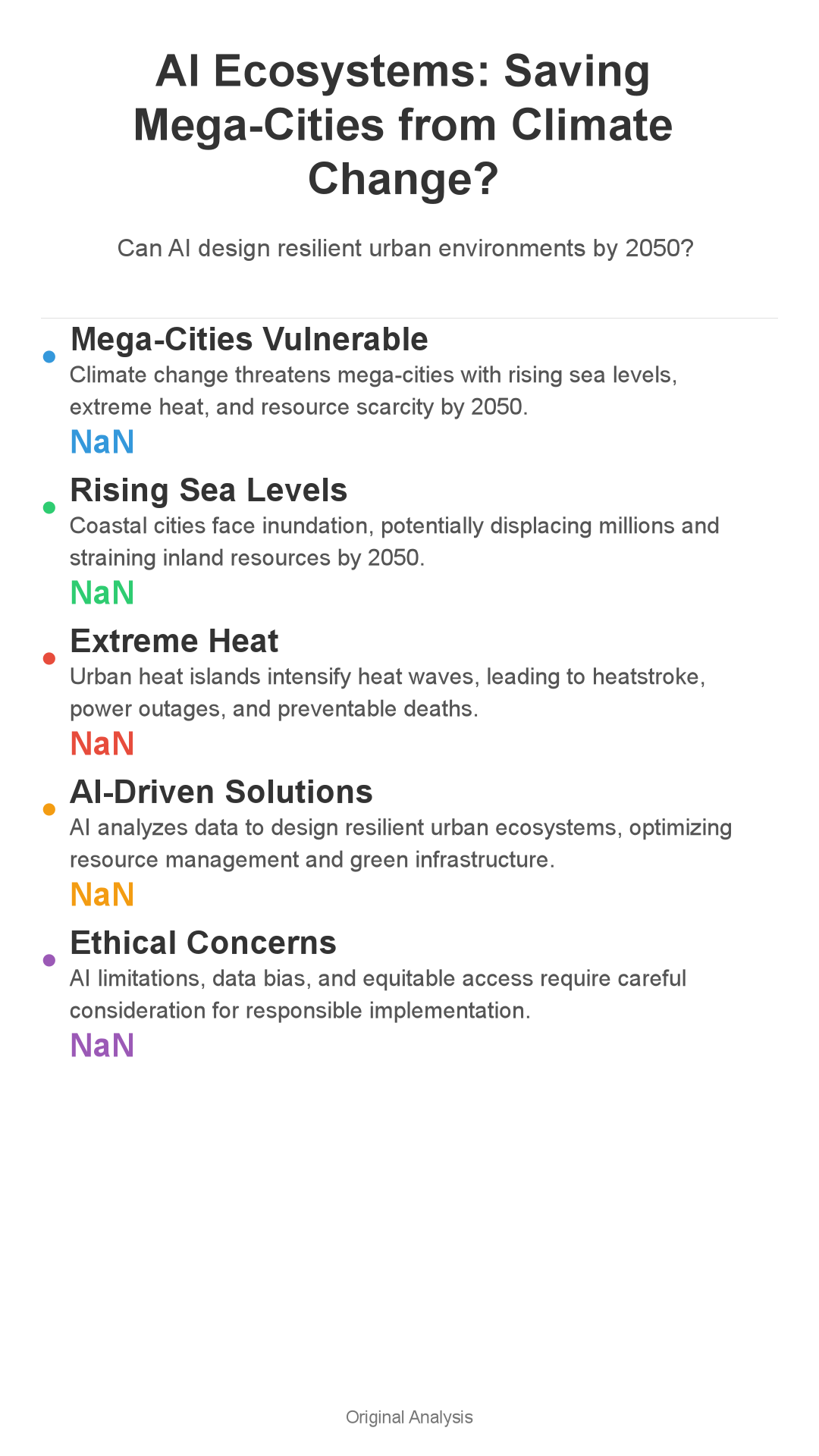
Could AI-designed ecosystems be the only thing standing between our mega-cities and total climate co
Imagine a future where climate change has pushed our cities to the brink. Could AI-designed ecosystems be the only thing standing between us and an unlivable world? If that sounds like a chilling sci-fi scenario ripped from tomorrow’s headlines, hit that like button! Let’s explore whether AI-designed ecosystems could be the lifeline for climate-ravaged mega-cities by 2050, and what that future might realistically entail. Follow us for more thought-provoking dives into the future!
The year is 2050. Miami is largely submerged, Mumbai is suffocating under relentless heat waves, and resource wars are erupting in the parched lands of what was once California. A grim picture, isn’t it?
But what if artificial intelligence offered a crucial solution, a way to save these mega-cities from utter collapse?
Climate Change Impacts: The Looming Crisis for Mega-Cities
Let’s be blunt: climate change is already causing widespread destruction, and mega-cities are exceptionally vulnerable. By 2050, the situation is projected to worsen dramatically.
Rising Sea Levels and Coastal Flooding
Rising sea levels pose an existential threat to coastal cities worldwide. Consider Jakarta, sinking so rapidly that Indonesia is relocating its capital. Or Bangladesh, where rising tides could displace millions.
By 2050, many low-lying coastal areas will likely become uninhabitable, triggering mass migrations and straining resources in inland cities.
Extreme Heat Events and Urban Heat Island Effect
Mega-cities intensify the impact of heat waves through the urban heat island effect. Concrete and asphalt absorb and trap heat, making urban areas significantly hotter than their rural surroundings.
Projections for 2050 paint a stark picture: longer, more frequent, and more intense heat waves, leading to increased cases of heatstroke, overwhelmed power grids, and preventable deaths.
Imagine New Delhi consistently experiencing temperatures exceeding 120°F (49°C).
Resource Scarcity (Water, Food)
Climate change intensifies resource scarcity, particularly concerning water and food. Droughts will become more frequent and severe, devastating agriculture and depleting water supplies.
Mega-cities, with their dense populations, will face fierce competition for these increasingly scarce resources, potentially triggering social unrest and even conflict.
Cape Town’s near “Day Zero” water crisis in 2018 serves as a stark warning of what many cities could face in the coming decades.
AI-Driven Ecosystem Design: A Potential Solution
Enter artificial intelligence. Could AI become the architect of our urban salvation? The concept is that AI can analyze vast amounts of environmental data and design ecosystems specifically tailored to individual urban environments, making them more resilient and sustainable.
Analyzing Environmental Data
AI can process massive datasets – including temperature readings, pollution levels, and biodiversity surveys – to pinpoint the most suitable plant and animal species for specific urban environments.
It can predict which species will flourish in a changing climate, which will effectively purify air and water, and which will provide other crucial ecosystem services.
Examples of AI-Designed Green Infrastructure
Envision vertical forests designed by AI, optimizing plant placement to maximize carbon sequestration and enhance biodiversity.
Or bio-integrated architecture that integrates living organisms into building materials, creating self-regulating and energy-efficient structures.
AI-managed urban farms could provide locally sourced food, reducing transportation costs and minimizing environmental impact. This represents a complete reimagining of how cities interact with the natural world.
Singapore’s “Gardens by the Bay” offers a glimpse of the potential of large-scale, technologically advanced green spaces, but AI could elevate this concept to unprecedented levels.
Optimizing Resource Management
AI can also optimize resource management within these ecosystems. Consider water recycling systems that purify wastewater for irrigation, or waste reduction programs that transform organic waste into fertilizer.
Overcoming Challenges and Ethical Considerations
Before we declare AI as our environmental savior, let’s examine the potential drawbacks. Relying solely on AI for ecosystem design raises significant ethical and practical concerns.
The Limitations of AI
AI’s effectiveness is limited by the quality of the data it’s trained on. If the data is biased or incomplete, the AI’s recommendations could be flawed, potentially leading to unintended ecological consequences.
Furthermore, AI lacks the human intuition and creativity essential for addressing complex environmental problems. We can’t simply entrust our planet’s future to algorithms and expect perfect outcomes. What happens when the AI makes a mistake?
Social Equity and Access
Who will benefit from AI-designed ecosystems? Will these green spaces be accessible to all residents, or will they be concentrated in affluent neighborhoods, leading to environmental gentrification?
Ensuring equitable distribution of benefits is critical to prevent further widening social inequalities. We must proactively ensure that everyone has access to clean air, green spaces, and healthy food, regardless of their socioeconomic status.
Ethical Implications of Relying Solely on AI
What happens to our connection with nature if we become entirely reliant on AI for environmental management? Do we risk losing our appreciation for the inherent value of the natural world? There’s also the potential for control and manipulation.
Who controls the AI? What if it’s used for purposes that conflict with the public good?
Implementation Strategies and Technological Advancements
Despite the challenges, the potential of AI-designed ecosystems remains undeniable. The key lies in implementing them strategically and ethically.
Integrating into Existing Urban Infrastructure
We need to identify ways to integrate AI-designed ecosystems into existing urban infrastructure.
This could involve retrofitting buildings with green walls and roofs, creating green corridors to connect fragmented habitats, and establishing urban nature reserves in underutilized spaces.
Advancements in Sensor Technology and Data Analytics
Real-time monitoring and adaptive management are vital for ensuring the long-term success of these ecosystems.
Advancements in sensor technology and data analytics will enable us to track environmental conditions, monitor plant and animal health, and make necessary adjustments.
Citizen Science and Community Involvement
Citizen science and community involvement can play a critical role in data collection and ecosystem maintenance.
By engaging local residents in monitoring and managing these green spaces, we can foster a sense of ownership and responsibility, ensuring their long-term sustainability.
So, what are your thoughts? Can we truly trust AI to design the ecosystems that will sustain us in a climate-ravaged future? Or are we venturing down a potentially perilous path? Share your opinions in the comments below!
If you enjoyed this in-depth exploration of the future of our cities, be sure to subscribe for more mind-expanding analyses of technology and its impact on our world. And don’t forget to share this article with your friends and family – let’s spark a vital conversation!

Enjoyed this? Check out our YouTube channel for video versions!
Enjoyed this? Check out our YouTube channel for video versions!



